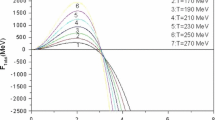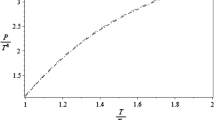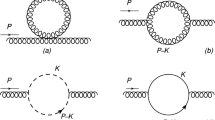Abstract
We use the recently obtained two-loop hard thermal loop perturbation theory thermodynamics functions of a plasma of quarks and gluons to compute the diagonal second- and fourth-order quark number susceptibilities. The two-loop hard thermal loop perturbation theory thermodynamic functions used are reliable in the limit that the ratio of the quark chemical potential to temperature is small. Using this result, we are able to obtain (semi-)analytic expressions for the quark number susceptibilities at leading- and next-to-leading-order in hard thermal loop perturbation theory. We compare the hard thermal loop perturbation theory results with perturbative quantum chromodynamics calculations, a Polyakov-loop Nambu-Jona-Lasinio model calculation, and lattice quantum chromodynamics results.
Similar content being viewed by others
References
M. Asakawa, U.W. Heinz and B. Müller, Fluctuation probes of quark deconfinement, Phys. Rev. Lett. 85 (2000) 2072 [hep-ph/0003169] [INSPIRE].
S. Jeon and V. Koch, Charged particle ratio fluctuation as a signal for QGP, Phys. Rev. Lett. 85 (2000) 2076 [hep-ph/0003168] [INSPIRE].
M. Cheng et al., Baryon number, strangeness and electric charge fluctuations in QCD at high temperature, Phys. Rev. D 79 (2009) 074505 [arXiv:0811.1006] [INSPIRE].
D. Forster, Hydrodynamics, fluctuation, broken symmetry and correlation function, Benjamin/Cummings, Menlo Park U.S.A. (1975).
H.B. Callen and T.A. Welton, Irreversibility and generalized noise, Phys. Rev. 83 (1951) 34 [INSPIRE].
R. Kubo, Statistical mechanical theory of irreversible processes. 1. General theory and simple applications in magnetic and conduction problems, J. Phys. Soc. Jpn. 12 (1957) 570 [INSPIRE].
L.D. McLerran, A chiral symmetry order parameter, the lattice and nucleosynthesis, Phys. Rev. D 36 (1987) 3291 [INSPIRE].
T. Hatsuda and T. Kunihiro, QCD phenomenology based on a chiral effective Lagrangian, Phys. Rept. 247 (1994) 221 [hep-ph/9401310] [INSPIRE].
T. Kunihiro, Quark number susceptibility and fluctuations in the vector channel at high temperatures, Phys. Lett. B 271 (1991) 395 [INSPIRE].
M.A. Stephanov, K. Rajagopal and E.V. Shuryak, Signatures of the tricritical point in QCD, Phys. Rev. Lett. 81 (1998) 4816 [hep-ph/9806219] [INSPIRE].
M.A. Stephanov, K. Rajagopal and E.V. Shuryak, Event-by-event fluctuations in heavy ion collisions and the QCD critical point, Phys. Rev. D 60 (1999) 114028 [hep-ph/9903292] [INSPIRE].
M. Stephanov, Non-Gaussian fluctuations near the QCD critical point, Phys. Rev. Lett. 102 (2009) 032301 [arXiv:0809.3450] [INSPIRE].
T. Toimela, Perturbative QED and QCD at finite temperatures and densities, Int. J. Theor. Phys. 24 (1985) 901 [Erratum ibid. 26 (1987) 1021] [INSPIRE].
J.I. Kapusta and C. Gale, Finite temperature field theory principle and applications, 2nd ed., Cambridge University Press, Cambridge U.K. (1996).
A. Vuorinen, Quark number susceptibilities of hot QCD up to g 6 ln g, Phys. Rev. D 67 (2003) 074032 [hep-ph/0212283] [INSPIRE].
S. Borsányi et al., QCD equation of state at nonzero chemical potential: continuum results with physical quark masses at order μ 2, JHEP 08 (2012) 053 [arXiv:1204.6710] [INSPIRE].
S. Borsányi et al., Fluctuations of conserved charges at finite temperature from lattice QCD, JHEP 01 (2012) 138 [arXiv:1112.4416] [INSPIRE].
A. Bazavov, H. Ding and P. Petreczky, Quark number susceptibilities and color screening at high temperatures, J. Phys. Conf. Ser. 389 (2012) 012017 [INSPIRE].
P. Petreczky, Lattice QCD at non-zero temperature, J. Phys. G 39 (2012) 093002 [arXiv:1203.5320] [INSPIRE].
RBC-Bielefeld collaboration, P. Petreczky, P. Hegde and A. Velytsky, Quark number fluctuations at high temperatures, PoS(LAT2009)159 [arXiv:0911.0196] [INSPIRE].
HotQCD collaboration, A. Bazavov et al., Fluctuations and correlations of net baryon number, electric charge and strangeness: a comparison of lattice QCD results with the hadron resonance gas model, Phys. Rev. D 86 (2012) 034509 [arXiv:1203.0784] [INSPIRE].
C. Allton et al., Thermodynamics of two flavor QCD to sixth order in quark chemical potential, Phys. Rev. D 71 (2005) 054508 [hep-lat/0501030] [INSPIRE].
A. Bazavov et al., Equation of state and QCD transition at finite temperature, Phys. Rev. D 80 (2009) 014504 [arXiv:0903.4379] [INSPIRE].
MILC collaboration, C. Bernard et al., QCD thermodynamics with three flavors of improved staggered quarks, Phys. Rev. D 71 (2005) 034504 [hep-lat/0405029] [INSPIRE].
M. Cheng et al., Baryon number, strangeness and electric charge fluctuations in QCD at high temperature, Phys. Rev. D 79 (2009) 074505 [arXiv:0811.1006] [INSPIRE].
R.V. Gavai and S. Gupta, Quark number susceptibilities, strangeness and dynamical confinement, Phys. Rev. D 64 (2001) 074506 [hep-lat/0103013] [INSPIRE].
R.V. Gavai and S. Gupta, The continuum limit of quark number susceptibilities, Phys. Rev. D 65 (2002) 094515 [hep-lat/0202006] [INSPIRE].
R.V. Gavai, S. Gupta and P. Majumdar, Susceptibilities and screening masses in two flavor QCD, Phys. Rev. D 65 (2002) 054506 [hep-lat/0110032] [INSPIRE].
K. Kusaka, Color singlet projection in the Nambu-Jona-Lasinio model at finite temperature, Phys. Lett. B 269 (1991) 17 [INSPIRE].
Y. Hatta and T. Ikeda, Universality, the QCD critical/tricritical point and the quark number susceptibility, Phys. Rev. D 67 (2003) 014028 [hep-ph/0210284] [INSPIRE].
C. Sasaki, B. Friman and K. Redlich, Quark number fluctuations in a chiral model at finite baryon chemical potential, Phys. Rev. D 75 (2007) 054026 [hep-ph/0611143] [INSPIRE].
C. Ratti, S. Roessner and W. Weise, Quark number susceptibilities: lattice QCD versus PNJL model, Phys. Lett. B 649 (2007) 57 [hep-ph/0701091] [INSPIRE].
S. Mukherjee, M.G. Mustafa and R. Ray, Thermodynamics of the PNJL model with nonzero baryon and isospin chemical potentials, Phys. Rev. D 75 (2007) 094015 [hep-ph/0609249] [INSPIRE].
S.K. Ghosh, T.K. Mukherjee, M.G. Mustafa and R. Ray, Susceptibilities and speed of sound from PNJL model, Phys. Rev. D 73 (2006) 114007 [hep-ph/0603050] [INSPIRE].
S.K. Ghosh, T.K. Mukherjee, M.G. Mustafa and R. Ray, PNJL model with a Van der Monde term, Phys. Rev. D 77 (2008) 094024 [arXiv:0710.2790] [INSPIRE].
S. Chatterjee and K.A. Mohan, Including the fermion vacuum fluctuations in the (2 + 1) flavor Polyakov quark meson model, Phys. Rev. D 85 (2012) 074018 [arXiv:1108.2941] [INSPIRE].
S. Chatterjee and K.A. Mohan, Fluctuations and correlations of conserved charges in the (2 + 1) Polyakov quark meson model, Phys. Rev. D 86 (2012) 114021 [arXiv:1201.3352] [INSPIRE].
A. Bhattacharyya, P. Deb, A. Lahiri and R. Ray, Susceptibilities with multi-quark interactions in PNJL model, Phys. Rev. D 82 (2010) 114028 [arXiv:1008.0768] [INSPIRE].
A. Bhattacharyya, P. Deb, A. Lahiri and R. Ray, Correlation between conserved charges in PNJL model with multi-quark interactions, Phys. Rev. D 83 (2011) 014011 [arXiv:1010.2394] [INSPIRE].
P. Chakraborty, M.G. Mustafa and M.H. Thoma, Quark number susceptibility in hard thermal loop approximation, Eur. Phys. J. C 23 (2002) 591 [hep-ph/0111022] [INSPIRE].
P. Chakraborty, M.G. Mustafa and M.H. Thoma, Quark number susceptibility, thermodynamic sum rule and hard thermal loop approximation, Phys. Rev. D 68 (2003) 085012 [hep-ph/0303009] [INSPIRE].
N. Haque, M.G. Mustafa and M.H. Thoma, Conserved density fluctuation and temporal correlation function in HTL perturbation theory, Phys. Rev. D 84 (2011) 054009 [arXiv:1103.3394] [INSPIRE].
N. Haque and M.G. Mustafa, Quark number susceptibility and thermodynamics in HTL approximation, Nucl. Phys. A 862–863 (2011) 271 [arXiv:1109.0799] [INSPIRE].
N. Haque and M.G. Mustafa, A modified hard thermal loop perturbation theory, arXiv:1007.2076 [INSPIRE].
J.-P. Blaizot, E. Iancu and A. Rebhan, Quark number susceptibilities from HTL resummed thermodynamics, Phys. Lett. B 523 (2001) 143 [hep-ph/0110369] [INSPIRE].
J. Blaizot, E. Iancu and A. Rebhan, Comparing different hard thermal loop approaches to quark number susceptibilities, Eur. Phys. J. C 27 (2003) 433 [hep-ph/0206280] [INSPIRE].
A. Rebhan and P. Romatschke, HTL quasiparticle models of deconfined QCD at finite chemical potential, Phys. Rev. D 68 (2003) 025022 [hep-ph/0304294] [INSPIRE].
Y. Jiang, H.-X. Zhu, W.-M. Sun and H.-S. Zong, The quark number susceptibility in hard thermal loop approximation, J. Phys. G 37 (2010) 055001 [arXiv:1003.5031] [INSPIRE].
J.O. Andersen, S. Mogliacci, N. Su and A. Vuorinen, Quark number susceptibilities from resummed perturbation theory, Phys. Rev. D 87 (2013) 074003 [arXiv:1210.0912] [INSPIRE].
M. He, D.-K. He, H.-T. Feng, W.-M. Sun and H.-S. Zong, Continuum study of quark-number susceptibility in an effective interaction model, Phys. Rev. D 76 (2007) 076005 [INSPIRE].
M. He, J.-F. Li, W.-M. Sun and H.-S. Zong, Quark number susceptibility around the critical end point, Phys. Rev. D 79 (2009) 036001 [arXiv:0811.1835] [INSPIRE].
D.-K. He, X.-X. Ruan, Y. Jiang, W.-M. Sun and H.-S. Zong, A model study of quark-number susceptibility at finite chemical potential and temperature, Phys. Lett. B 680 (2009) 432 [INSPIRE].
Y. Jiang, L.-J. Luo and H.-S. Zong, A model study of quark number susceptibility at finite temperature beyond rainbow-ladder approximation, JHEP 02 (2011) 066 [arXiv:1102.1532] [INSPIRE].
K.-I. Kim, Y. Kim, S. Takeuchi and T. Tsukioka, Quark number susceptibility with finite quark mass in holographic QCD, Prog. Theor. Phys. 126 (2011) 735 [arXiv:1012.2667] [INSPIRE].
L.-X. Cui, S. Takeuchi and Y.-L. Wu, Quark number susceptibility and QCD phase transition in the predictive soft-wall AdS/QCD model with finite temperature, Phys. Rev. D 84 (2011) 076004 [arXiv:1107.2738] [INSPIRE].
Y. Kim, S. Takeuchi and T. Tsukioka, Quark number susceptibility in holographic QCD, Prog. Theor. Phys. Suppl. 186 (2010) 498 [INSPIRE].
B.-J. Schäfer and J. Wambach, Susceptibilities near the QCD (tri)critical point, Phys. Rev. D 75 (2007) 085015 [hep-ph/0603256] [INSPIRE].
B.-J. Schäfer, M. Wagner and J. Wambach, Thermodynamics of (2 + 1)-flavor QCD: confronting models with lattice studies, Phys. Rev. D 81 (2010) 074013 [arXiv:0910.5628] [INSPIRE].
M. Bluhm, B. Kampfer and G. Soff, The QCD equation of state near T c within a quasi-particle model, Phys. Lett. B 620 (2005) 131 [hep-ph/0411106] [INSPIRE].
M. Bluhm and B. Kampfer, Flavor diagonal and off-diagonal susceptibilities in a quasiparticle model of the quark-gluon plasma, Phys. Rev. D 77 (2008) 114016 [arXiv:0801.4147] [INSPIRE].
E. Braaten and R.D. Pisarski, Soft amplitudes in hot gauge theories: a general analysis, Nucl. Phys. B 337 (1990) 569 [INSPIRE].
E. Braaten and R.D. Pisarski, Resummation and gauge invariance of the gluon damping rate in hot QCD, Phys. Rev. Lett. 64 (1990) 1338 [INSPIRE].
E. Braaten and R.D. Pisarski, Simple effective Lagrangian for hard thermal loops, Phys. Rev. D 45 (1992) 1827 [INSPIRE].
J.O. Andersen, E. Braaten and M. Strickland, Hard thermal loop resummation of the free energy of a hot gluon plasma, Phys. Rev. Lett. 83 (1999) 2139 [hep-ph/9902327] [INSPIRE].
J.O. Andersen, E. Braaten and M. Strickland, Hard thermal loop resummation of the thermodynamics of a hot gluon plasma, Phys. Rev. D 61 (2000) 014017 [hep-ph/9905337] [INSPIRE].
J.O. Andersen, E. Braaten and M. Strickland, Hard thermal loop resummation of the free energy of a hot quark-gluon plasma, Phys. Rev. D 61 (2000) 074016 [hep-ph/9908323] [INSPIRE].
J.O. Andersen, E. Braaten, E. Petitgirard and M. Strickland, HTL perturbation theory to two loops, Phys. Rev. D 66 (2002) 085016 [hep-ph/0205085] [INSPIRE].
J.O. Andersen, E. Petitgirard and M. Strickland, Two loop HTL thermodynamics with quarks, Phys. Rev. D 70 (2004) 045001 [hep-ph/0302069] [INSPIRE].
J.O. Andersen, M. Strickland and N. Su, Gluon thermodynamics at intermediate coupling, Phys. Rev. Lett. 104 (2010) 122003 [arXiv:0911.0676] [INSPIRE].
J.O. Andersen, M. Strickland and N. Su, Three-loop HTL gluon thermodynamics at intermediate coupling, JHEP 08 (2010) 113 [arXiv:1005.1603] [INSPIRE].
J.O. Andersen, L.E. Leganger, M. Strickland and N. Su, NNLO hard-thermal-loop thermodynamics for QCD, Phys. Lett. B 696 (2011) 468 [arXiv:1009.4644] [INSPIRE].
J.O. Andersen, L.E. Leganger, M. Strickland and N. Su, Three-loop HTL QCD thermodynamics, JHEP 08 (2011) 053 [arXiv:1103.2528] [INSPIRE].
J.O. Andersen, L.E. Leganger, M. Strickland and N. Su, The QCD trace anomaly, Phys. Rev. D 84 (2011) 087703 [arXiv:1106.0514] [INSPIRE].
N. Haque, M.G. Mustafa and M. Strickland, Two-loop HTL pressure at finite temperature and chemical potential, Phys. Rev. D 87 (2013) 105007 [arXiv:1212.1797] [INSPIRE].
P. Chakraborty, M.G. Mustafa and M.H. Thoma, Chiral susceptibility in hard thermal loop approximation, Phys. Rev. D 67 (2003) 114004 [hep-ph/0210159] [INSPIRE].
A. Bazavov et al., Determination of α s from the QCD static energy, Phys. Rev. D 86 (2012) 114031 [arXiv:1205.6155] [INSPIRE].
S. Borsányi, Thermodynamics of the QCD transition from lattice, Nucl. Phys. A904-905 (2013) 270c [arXiv:1210.6901] [INSPIRE].
Author information
Authors and Affiliations
Corresponding author
Additional information
ArXiv ePrint: 1302.3228v2
Rights and permissions
About this article
Cite this article
Haque, N., Mustafa, M.G. & Strickland, M. Quark number susceptibilities from two-loop hard thermal loop perturbation theory. J. High Energ. Phys. 2013, 184 (2013). https://doi.org/10.1007/JHEP07(2013)184
Received:
Revised:
Accepted:
Published:
DOI: https://doi.org/10.1007/JHEP07(2013)184




